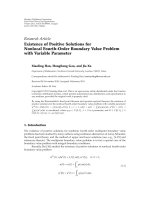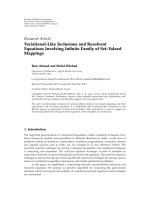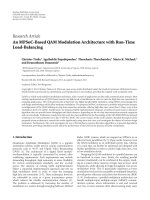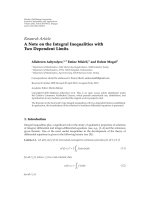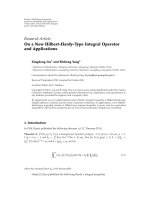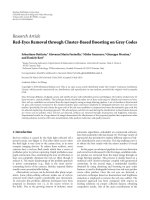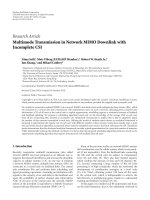báo cáo hóa học:" Research Article Variational Approach to Impulsive Differential Equations with Dirichlet Boundary Conditions" pptx
Bạn đang xem bản rút gọn của tài liệu. Xem và tải ngay bản đầy đủ của tài liệu tại đây (529.2 KB, 16 trang )
Hindawi Publishing Corporation
Boundary Value Problems
Volume 2010, Article ID 325415, 16 pages
doi:10.1155/2010/325415
Research Article
Variational Approach to Impulsive Differential
Equations with Dirichlet Boundary Conditions
Huiwen Chen and Jianli Li
Department of Mathematics, Hunan Normal University, Changsha, Hunan 410081, China
Correspondence should be addressed to Jianli Li,
Received 18 September 2010; Accepted 9 November 2010
Academic Editor: Zhitao Zhang
Copyright q 2010 H. Chen and J. Li. This is an open access article distributed under the Creative
Commons Attribution License, which permits unrestricted use, distribution, and reproduction in
any medium, provided the original work is properly cited.
We study the existence of n distinct pairs of nontrivial solutions for impulsive differential equations
with Dirichlet boundary conditions by using variational methods and critical point theory.
1. Introduction
Impulsive effects exist widely in many evolution processes in which their states are changed
abruptly at certain moments of time. Such processes are naturally seen in control theory 1, 2,
population dynamics 3, and medicine 4, 5. Due to its significance, a great deal of work has
been done in the theory of impulsive differential equations. In recent years, many researchers
have used some fixed point theorems 6, 7, topological degree theory 8, and the method
of lower and upper solutions with monotone iterative technique 9 to study the existence of
solutions for impulsive differential equations.
On the other hand, in the last few years, some researchers have used variational
methods to study the existence of solutions for boundary value problems 10–16, especially,
in 14–16, the authors have studied the existence of infinitely many solutions by using
variational methods.
However, as far as we know, few researchers have studied the existence of n distinct
pairs of nontrivial solutions for impulsive boundary value problems by using variational
methods.
2 Boundary Value Problems
Motivated by the above facts, in this paper, our aim is to study the existence of n
distinct pairs of nontrivial solutions to the Dirichlet boundary problem for the second-order
impulsive differential equations
u
t
λh
t, u
t
0,t
/
t
j
, a.e.t∈
0,T
,
−Δu
t
j
I
j
u
t
j
,j 1, 2, ,p,
u
0
u
T
0,
1.1
where 0 t
0
<t
1
< ···<t
p
<t
p1
T, λ>0, h ∈ C0,T × R, R, I
j
∈ CR, R, j 1, 2, ,p,
Δu
t
j
u
t
j
− u
t
−
j
, u
t
j
and u
t
−
j
denote the right and the left limits, respectively, of
u
t
j
at t t
j
, j 1, 2, ,p.
2. Preliminaries
Definition 2.1. Suppose that E is a Banach space and ϕ ∈ C
1
E, R. If any sequence {u
k
}⊂E
for which ϕu
k
is bounded and ϕ
u
k
→ 0ask → ∞ possesses a convergent subsequence
in E, we say that ϕ satisfies the Palais-Smale condition.
Let E be a real Banach space. Define the set Σ{A | A ⊂ E \{θ} as symmetric closed
set}.
Theorem 2.2 see 17, Theorem 3.5.3. Let E be a real Banach space, and let ϕ ∈ C
1
E, R
be an even functional which satisfies the Palais-Smale condition, ϕ is bounded from below and
ϕ00; suppose that there exists a set K ⊂ Σ and an odd homeomorphism h : K → S
n−1
n −
one-dimensional unit sphere and sup
x∈K
ϕx < 0,thenϕ has at least n distinct pairs of nontrivial
critical points.
To begin with, we introduce some notation. Denote by X the Sobolev space H
1
0
0,T,
and consider the inner product
u, v
T
0
u
t
v
t
dt 2.1
and the norm
u
T
0
u
t
2
dt
1/2
. 2.2
Hence, X is reflexive. We define the norm in C0,T as x
∞
max
t∈0,T
|xt|.
For u ∈ H
2
0,T, we have that u and u
are absolutely continuous and u
∈ L
2
0,T.
Hence, Δu
tu
t
− u
t
−
0 for every t ∈ 0,T.Ifu ∈ H
1
0
0,T, then u is absolutely
continuous and u
∈ L
2
0,T. In this case, the one-sided derivatives u
t
−
, u
t
may not
exist. As a consequence, we need to introduce a different concept of solution. Suppose that
u ∈ C0,T such that for every j 1, 2, ,p, u
j
u|
t
j
,t
j1
satisfies u
j
∈ H
2
t
j
,t
j1
,and
it satisfies the equation in problem 1.1 for t
/
t
j
,a.e.t ∈ 0,T, the limits u
t
j
,u
t
−
j
,and
Boundary Value Problems 3
j 1, 2, ,pexist, and impulsive conditions and boundary conditions in problem 1.1 hold,
we say it is a classical solution of problem 1.1.
Consider the functional
ϕ : X −→ R, 2.3
defined by
ϕ
u
1
2
u
2
− λ
T
0
H
t, u
t
dt −
p
j1
ut
j
0
I
j
s
ds, 2.4
where Ht, u
u
0
ht, sds. Clearly, ϕ is a Fr
´
echet differentiable functional, whose Fr
´
echet
derivative at the point u ∈ X is the functional ϕ
u ∈ X
∗
given by
ϕ
u
v
T
0
u
t
v
t
dt − λ
T
0
h
t, u
t
v
t
dt −
p
j1
I
j
u
t
j
v
t
j
, 2.5
for any v ∈ X. Obviously, ϕ
is continuous.
Lemma 2.3. If u ∈ X is a critical point of the functional ϕ, then u is a classical solution of problem
1.1.
Proof. The proof is similar to t he proof of 16, Lemma 2.4, and we omit it here.
Lemma 2.4. Let u ∈ X,thenu
∞
≤
√
Tu.
Proof. For u ∈ X, then u0uT0. Hence, for t ∈ 0,T,byH
¨
older’s inequality, we have
|
u
t
|
t
0
u
s
ds
≤
T
0
u
s
ds ≤
√
T
T
0
u
s
2
ds
1/2
√
T
u
, 2.6
which completes the proof.
3. Main Results
Theorem 3.1. Suppose that the following conditions hold.
i There exist a, b > 0 and γ ∈ 0, 1 such that
|
h
t, u
|
≤ a b
|
u
|
γ
for any
t, u
∈
0,T
× R. 3.1
ii ht, u is odd about u and Ht, u > 0 for every t, u ∈ 0,T × R \{0}.
iii I
j
uj 1, 2, ,p are odd and
u
0
I
j
sds ≤ 0 for any u ∈ R j 1, 2, ,p.
4 Boundary Value Problems
Then for any n ∈ N, there exists λ
n
such that λ>λ
n
, and problem 1.1 has at least n distinct
pairs of nontrivial classical solutions.
Proof. By 2.4, ii,andiii, ϕ ∈ C
1
X, R is an even functional and ϕ00.
Next, we will verify that ϕ is bounded from below. In view of i, iii,andLemma 2.4,
we have
ϕ
u
1
2
u
2
− λ
T
0
H
t, u
t
dt −
p
j1
ut
j
0
I
j
s
ds
≥
1
2
u
2
− λ
T
0
a
|
u
t
|
b
|
u
t
|
γ1
dt
≥
1
2
u
2
− λaT
3/2
u
− λbT
γ3/2
u
γ1
> −∞,
3.2
for any u ∈ X.Thatis,ϕ is bounded from below.
In the following we will show that ϕ satisfies the Palais-Smale condition. Let {u
k
}⊂X,
such that {ϕu
k
} is a bounded sequence and lim
k →∞
ϕ
u
k
0. Then, there exists M>0
such that
ϕ
u
k
≤ M. 3.3
In view of 3.2, we have
M ≥
1
2
u
k
2
− λaT
3/2
u
k
− λbT
γ3/2
u
k
γ1
. 3.4
So {u
k
} is bounded in X. From the reflexivity of X, we may extract a weakly convergent
subsequence that, for simplicity, we call {u
k
}, u
k
uin X. Next, we will verify that {u
k
}
strongly converges to u in X.By2.5, we have
ϕ
u
k
− ϕ
u
u
k
− u
u
k
− u
2
− λ
T
0
h
t, u
k
t
− h
t, u
t
u
k
t
− u
t
dt
p
j1
I
j
u
k
t
j
− I
j
u
t
j
u
k
t
j
− u
t
j
.
3.5
By u
k
uin X,weseethat{u
k
} uniformly converges to u in C0,T.So,
λ
T
0
h
t, u
k
t
− h
t, u
t
u
k
t
− u
t
dt −→ 0,
p
j1
I
j
u
k
t
j
− I
j
u
t
j
u
k
t
j
− u
t
j
−→ 0ask −→ ∞.
3.6
Boundary Value Problems 5
By lim
k →∞
ϕ
u
k
0andu
k
u, we have
ϕ
u
k
− ϕ
u
u
k
− u
−→ 0ask −→ ∞. 3.7
In view of 3.5, 3.6,and3.7,weobtainu
k
− u→0ask →∞. Then, ϕ satisfies the
Palais-Smale condition.
Let v
m
t
√
2T/mπ sinmπ/Tt, m 1, 2, ,n, then
v
m
2
1
m
2
π
2
T
2
T
0
|
v
m
t
|
2
dt, m 1, 2, ,n. 3.8
Define
K
n
r
n
m1
c
m
v
m
|
n
m1
c
2
m
r
2
,r>0. 3.9
Then, for any r>0, there exists an odd homeomorphism f : K
n
r → S
n−1
.Let0<r<1/
√
T,
then u
∞
≤
√
Tu
√
Tr < 1 for any u ∈ K
n
r.Byii, we have
H
t, u
t
ut
0
h
t, s
ds > 0asu
t
/
0, 3.10
then
T
0
Ht, utdt > 0 for any u ∈ K
n
r.
Let α
n
inf
u∈K
n
r
T
0
Ht, utdt, β
n
inf
u∈K
n
r
p
j1
ut
j
0
I
j
sds, then α
n
> 0, β
n
≤ 0.
Let λ
n
1/2r
2
− β
n
α
−1
n
> 0, then when λ>λ
n
, for any u ∈ K
n
r, we have
ϕ
u
≤
1
2
r
2
− λα
n
− β
n
<
1
2
r
2
− λ
n
α
n
− β
n
0.
3.11
By Theorem 2.2, ϕ possesses at least n distinct pairs of nontrivial critical points. That is,
problem 1.1 has at least n distinct pairs of nontrivial classical solutions.
Corollary 3.2. Let the following conditions hold:
i ht, u is bounded,
ii ht, u is odd about u and Ht, u > 0 for every t, u ∈ 0,T × R \{0},
iii I
j
uj 1, 2, ,p are odd and
u
0
I
j
sds ≤ 0 for any u ∈ R j 1, 2, ,p.
Then, for any n ∈ N,thereexistsλ
n
such that λ>λ
n
, and problem 1.1 has at least n distinct
pairs of nontrivial classical solutions.
6 Boundary Value Problems
Proof. Let γ 0inTheorem 3.1, then Corollary 3.2 holds.
Theorem 3.3. Suppose that the following conditions hold.
i There exists a, b > 0 and γ ∈ 0, 1 such that
|
h
t, u
|
≤ a b
|
u
|
γ
for any
t, u
∈
0,T
× R. 3.12
ii There exists a
j
,b
j
> 0 and γ
j
∈ 0, 1j 1, 2, ,p such that
I
j
u
≤ a
j
b
j
|
u
|
γ
j
for any u ∈ R
j 1, 2, ,p
. 3.13
iii ht, u and I
j
uj 1, 2, ,p are odd about u and Ht, u > 0 for every t, u ∈
0,T × R \{0}.
Then, for any n ∈ N,thereexistsλ
n
such that λ>λ
n
, and problem 1.1 has at least n distinct
pairs of nontrivial classical solutions.
Proof. By 2.4 and iii, ϕ ∈ C
1
X, R is an even functional and ϕ00.
Next, we will verify that ϕ is bounded from below. Let M
1
max{a
1
,a
2
, ,a
p
}, M
2
max{b
1
,b
2
, ,b
p
}.Inviewofi, ii,andLemma 2.4, we have
ϕ
u
1
2
u
2
− λ
T
0
H
t, u
t
dt
p
j1
ut
j
0
I
j
s
ds
≥
1
2
u
2
− λ
T
0
a
|
u
t
|
b
|
u
t
|
γ1
dt
−
p
j1
a
j
u
t
j
b
j
u
t
j
γ
j
1
≥
1
2
u
2
− λaT
3/2
u
− λbT
γ3/2
u
γ1
− pM
1
√
T
u
− M
2
p
j1
T
γ
j
1/2
u
γ
j
1
> −∞,
3.14
for any u ∈ X.Thatis,ϕ is bounded from below.
In the following, we will show that ϕ satisfies the Palais-Smale condition. As in the
proof of Theorem 3.1,by3.3 and 3.14, we have
M ≥
1
2
u
k
2
− λaT
3/2
u
k
− λbT
γ3/2
u
k
γ1
− pM
1
√
T
u
k
− M
2
p
j1
T
γ
j
1/2
u
k
γ
j
1
.
3.15
Boundary Value Problems 7
It follows that {u
k
} is bounded in X. In the following, the proof of the Palais-Smale condition
is the same as that in Theorem 3.1, and we omit it here.
Take the same K
n
r as in Theorem 3.1, then for any r>0, there exists an odd
homeomorphism f : K
n
r → S
n−1
.Let0<r<1/
√
T, then u
∞
≤
√
Tu
√
Tr < 1
for any u ∈ K
n
r.Byiii, we have
H
t, u
t
ut
0
h
t, s
ds > 0asu
t
/
0. 3.16
Then,
T
0
Ht, utdt > 0 for any u ∈ K
n
r.
Let α
n
inf
u∈K
n
r
T
0
Ht, utdt, β
n
inf
u∈K
n
r
p
j1
ut
j
0
I
j
sds, then α
n
> 0. Let
λ
n
max{0, 1/2r
2
− β
n
α
−1
n
}, then when λ>λ
n
, for any u ∈ K
n
r, we have
ϕ
u
≤
1
2
r
2
− λα
n
− β
n
<
1
2
r
2
− λ
n
α
n
− β
n
≤ 0. 3.17
By Theorem 2.2, ϕ possesses at least n distinct pairs of nontrivial critical points. That is,
problem 1.1 has at least n distinct pairs of nontrivial classical solutions.
Corollary 3.4. Let the following conditions hold:
i ht, u is bounded,
ii I
j
uj 1, 2, ,p are bounded,
iii ht, u and I
j
uj 1, 2, ,p are odd about u and Ht, u > 0 for every t, u ∈
0,T × R \{0}.
Then, for any n ∈ N,thereexistsλ
n
such that λ>λ
n
, and problem 1.1 has at least n distinct
pairs of nontrivial classical solutions.
Proof. Let γ 0andγ
j
0 j 1, 2, ,p in Theorem 3.3, then Corollary 3.4 holds.
Theorem 3.5. Suppose that the following conditions hold.
i There exist constants σ>0 such that ht, σ0,ht, u > 0 for every u ∈ 0,σ.
ii ht, u is odd about u.
iii I
j
uj 1, 2, ,p are odd and
u
0
I
j
sds ≤ 0 for any u ∈ R j 1, 2, ,p.
Then, for any n ∈ N,thereexistsλ
n
such that λ>λ
n
, and problem 1.1 has at least n distinct
pairs of nontrivial classical solutions.
Proof. Let
h
1
t, u
⎧
⎪
⎪
⎪
⎨
⎪
⎪
⎪
⎩
h
t, σ
,u>σ,
h
t, u
,
|
u
|
≤ σ,
h
t, −σ
,u<−σ,
3.18
8 Boundary Value Problems
then h
1
t, u is continuous, bounded, and odd. Consider boundary value problem
u
t
λh
1
t, u
t
0,t
/
t
j
, a.e.t∈
0,T
,
−Δu
t
j
I
j
u
t
j
,j 1, 2, ,p,
u
0
u
T
0.
3.19
Next, we will verify that the solutions of problem 3.19 are solutions of problem 1.1. In fact,
let u
0
t be the solution of problem 3.19. If max
0≤t≤T
u
0
t >σ, then there exists an interval
a, b ⊂ 0,T such that
u
0
a
u
0
b
σ, u
0
t
>σ for any t ∈
a, b
. 3.20
When t ∈ a, b,byi, we have
u
0
t
−λh
1
t, u
−λh
t, σ
0. 3.21
Thus, there exist constants c such that u
0
tc for any t ∈ a, b. We consider the following
two possible cases.
Case 1. c ≥ 0, then u
0
is nondecreasing in a, b.Byu
0
a ≥ 0andu
0
b ≤ 0, we have
0 ≤ u
0
a
≤ u
0
t
≤ u
0
b
≤ 0 for every t ∈
a, b
. 3.22
That is, u
0
t ≡ 0 for any t ∈ a, b. So, there exists a constant d such that u
0
t ≡ d, which
contradicts 3.20. Then, max
0≤t≤T
u
0
t ≤ σ. Similarly, we can prove that min
0≤t≤T
u
0
t ≥−σ.
Case 2. c<0, the arguments are analogous, then u
0
t is solution of problem 1.1.
For every u ∈ X, we consider the functional
ϕ
1
: X −→ R, 3.23
defined by
ϕ
1
u
1
2
u
2
− λ
T
0
H
1
t, u
t
dt −
p
j1
ut
j
0
I
j
s
ds, 3.24
where H
1
t, u
u
0
h
1
t, sds.
It is clear that ϕ
1
is Fr
´
echet differentiable at any u ∈ X and
ϕ
1
u
v
T
0
u
t
v
t
dt − λ
T
0
h
1
t, u
t
v
t
dt −
p
j1
I
j
u
t
j
v
t
j
, 3.25
Boundary Value Problems 9
for any v ∈ X. Obviously, ϕ
1
is continuous. By Lemma 2.3, we have the critical points of ϕ
1
as
solutions of problem 3.19.By3.24, ii,andiii, ϕ
1
∈ C
1
X, R is an even functional and
ϕ
1
00.
In the following, we will show that ϕ
1
is bounded from below. since h
1
t, u0for
|u|≥σ,thus
T
0
H
1
t, u
t
dt
T
0
ut
0
h
1
t, s
ds dt ≤
T
0
σ
0
h
1
t, s
ds dt e>0. 3.26
By iii, we have
ϕ
1
u
1
2
u
2
− λ
T
0
H
1
t, u
t
dt −
p
j1
ut
j
0
I
j
s
ds
≥
1
2
u
2
− λe ≥−λe,
3.27
for any u ∈ X.Thatis,ϕ
1
is bounded from below.
In the following we will show that ϕ
1
satisfies the Palais-Smale condition. Let {u
k
}⊂X
such that {ϕ
1
u
k
} is a bounded sequence and lim
k →∞
ϕ
1
u
k
0. Then, there exists M
3
> 0
such that
ϕ
1
u
k
≤ M
3
. 3.28
By 3.27, we have
1
2
u
k
2
≤ M
3
λe. 3.29
It follows that {u
k
} is bounded in X. In the following, the proof of the Palais-Smale condition
is the same as that in Theorem 3.1, and we omit it here.
Take the same K
n
r as in Theorem 3.1, then, for any r>0, there exists an odd
homeomorphism f : K
n
r → S
n−1
.Let0<r<σ/
√
T, then u
∞
≤
√
Tu
√
Tr < σ
for any u ∈ K
n
r.Byi and ii, we have
H
1
t, u
t
ut
0
h
1
t, s
ds
ut
0
h
t, s
dt > 0asu
t
/
0. 3.30
Then,
T
0
H
1
t, utdt > 0 for any u ∈ K
n
r.
10 Boundary Value Problems
Let α
n
inf
u∈K
n
r
T
0
H
1
t, utdt, β
n
inf
u∈K
n
r
p
j1
ut
j
0
I
j
sds, then α
n
> 0, β
n
≤ 0.
Let λ
n
1/2r
2
− β
n
α
−1
n
> 0, then when λ>λ
n
, for any u ∈ K
n
r, we have
ϕ
1
u
≤
1
2
r
2
− λα
n
− β
n
<
1
2
r
2
− λ
n
α
n
− β
n
0.
3.31
By Theorem 2.2, ϕ
1
possesses at least n distinct pairs of nontrivial critical points. Then,
problem 3.19 has at least n distinct pairs of nontrivial classical solutions, that is, problem
1.1 has at least n distinct pairs of nontrivial classical solutions
Theorem 3.6. Let the following conditions hold.
i There exist constants σ>0 such that ht, σ0,ht, u > 0 for every u ∈ 0,σ.
ii There exist a
j
,b
j
> 0, and γ
j
∈ 0, 1j 1, 2, ,p such that
I
j
u
≤ a
j
b
j
|
u
|
γ
j
for any u ∈ R
j 1, 2, ,p
. 3.32
iii ht, u and I
j
uj 1, 2, ,p are odd about u.
Then, for any n ∈ N,thereexistsλ
n
such that λ>λ
n
, and problem 1.1 has at least n distinct
pairs of nontrivial classical solutions.
Proof. The proof is similar to t he proof of Theorem 3.5, and we omit it here.
Theorem 3.7. Let the following conditions hold.
i There exist constants σ
1
> 0 such that ht, σ
1
≤ 0.
ii There exist a
j
,b
j
> 0, and γ
j
∈ 0, 1j 1, 2, ,p such that
I
j
u
≤ a
j
b
j
|
u
|
γ
j
for any u ∈ R
j 1, 2, ,p
. 3.33
iii ht, u and I
j
uj 1, 2, ,p are odd about u and lim
u →0
ht, u/u 1 uniformly for
t ∈ 0,T.
Then, for any n ∈ N,thereexistsλ
n
such that λ>λ
n
, and problem 1.1 has at least n distinct
pairs of nontrivial classical solutions.
Proof. Let
h
2
t, u
⎧
⎪
⎪
⎪
⎨
⎪
⎪
⎪
⎩
h
t, σ
1
,u>σ
1
,
h
t, u
,
|
u
|
≤ σ
1
,
h
t, −σ
1
,u<−σ
1
,
3.34
Boundary Value Problems 11
then h
2
t, u is continuous, bounded, and odd. Consider boundary value problem
u
t
λh
2
t, u
t
0,t
/
t
j
, a.e.t∈
0,T
,
−Δu
t
j
I
j
u
t
j
,j 1, 2, ,p,
u
0
u
T
0.
3.35
Next, we will verify that the solutions of problem 3.35 are solutions of problem 1.1. In fact,
let u
0
t be the solution of problem 3.35. I f max
0≤t≤T
u
0
t >σ
1
, then there exists an interval
a, b ⊂ 0,T such that
u
0
a
u
0
b
σ
1
,u
0
t
>σ
1
for any t ∈
a, b
. 3.36
When t ∈ a, b,byi, we have
u
0
t
−λh
2
t, u
−λh
t, σ
1
≥ 0. 3.37
Thus, u
0
t is nondecreasing in a, b.Byu
0
a ≥ 0andu
0
b ≤ 0, we have
0 ≤ u
0
a
≤ u
0
t
≤ u
0
b
≤ 0 for every t ∈
a, b
. 3.38
That is, u
0
t ≡ 0 for any t ∈ a, b. So, there exists a constant d such that u
0
t ≡ d, which
contradicts 3.36. Then max
0≤t≤T
u
0
t ≤ σ
1
. Similarly, we can prove that min
0≤t≤T
u
0
t ≥−σ
1
.
Then, u
0
t is solution of problem 1.1.
For every u ∈ X, we consider the functional
ϕ
2
: X −→ R, 3.39
defined by
ϕ
2
u
1
2
u
2
− λ
T
0
H
2
t, u
t
dt −
p
j1
ut
j
0
I
j
s
ds, 3.40
where H
2
t, u
u
0
h
2
t, sds.
It is clear that ϕ
2
is Fr
´
echet differentiable at any u ∈ X and
ϕ
2
u
v
T
0
u
t
v
t
dt − λ
T
0
h
2
t, u
t
v
t
dt −
p
j1
I
j
u
t
j
v
t
j
, 3.41
for any v ∈ X. Obviously, ϕ
2
is continuous. By Lemma 2.3, we have the critical points of ϕ
2
as solutions of problem 3.35.By3.40 and iii, ϕ
2
∈ C
1
X, R is an even functional and
ϕ
2
00.
12 Boundary Value Problems
Next, we will show that ϕ
2
is bounded from below. Let M
1
max{a
1
,a
2
, ,a
p
},
M
2
max{b
1
,b
2
, ,b
p
}.sinceuh
2
t, u ≤ 0for|u|≥σ
1
,thus
T
0
H
2
t, u
t
dt
T
0
ut
0
h
2
t, s
ds dt ≤
T
0
σ
1
0
h
2
t, s
ds dt e. 3.42
By ii and Lemma 2.4, we have
ϕ
2
u
1
2
u
2
− λ
T
0
H
2
t, u
t
dt −
p
j1
ut
j
0
I
j
s
ds
≥
1
2
u
2
− λe − pM
1
√
T
u
− M
2
p
j1
T
γ
j
1/2
u
γ
j
1
> −∞,
3.43
for any u ∈ X.Thatis,ϕ
2
is bounded from below.
In the following we will show that ϕ
2
satisfies the Palais-Smale condition. Let {u
k
}⊂X
such that {ϕ
2
u
k
} is a bounded sequence and lim
k →∞
ϕ
2
u
k
0. Then, there exists M
4
> 0
such that
ϕ
2
u
k
≤ M
4
. 3.44
By 3.43, we have
1
2
u
k
2
≤ M
4
λe pM
1
√
T
u
k
M
2
p
j1
T
γ
j
1/2
u
k
γ
j
1
. 3.45
It follows that {u
k
} is bounded in X. In the following, the proof of the Palais-Smale condition
is the same as that in Theorem 3.1, and we omit it here.
Take the same K
n
r as in Theorem 3.1, then for any r>0, there exists an odd
homeomorphism f : K
n
r → S
n−1
.Byiii, for any 0 <ε<1, there exists δ>0, when
|u|≤δ, we have
h
2
t, u
≥ u − ε
|
u
|
. 3.46
Let 0 <r<min{σ
1
/
√
T,δ/
√
T}, then u
∞
≤
√
Tu
√
Tr < min{σ
1
,δ} for any u ∈ K
n
r.
Then,
T
0
H
2
t, utdt
T
0
ut
0
h
2
t, sdt ≥
T
0
1/21 − ε|ut|
2
dt > 0 for any u ∈ K
n
r.
Boundary Value Problems 13
Let α
n
inf
u∈K
n
r
T
0
H
2
t, utdt, β
n
inf
u∈K
n
r
p
j1
ut
j
0
I
j
sds, then α
n
> 0. Let
λ
n
max{1/2r
2
− β
n
α
−1
n
, 0}, then when λ>λ
n
, for any u ∈ K
n
r, we have
ϕ
1
u
≤
1
2
r
2
− λα
n
− β
n
<
1
2
r
2
− λ
n
α
n
− β
n
≤ 0.
3.47
By Theorem 2.2, ϕ
2
possesses at least n distinct pairs of nontrivial critical points. Then,
problem 3.35 has at least n distinct pairs of nontrivial classical solutions, that is, problem
1.1 has at least n distinct pairs of nontrivial classical solutions.
Theorem 3.8. Let the following conditions hold.
i There exist constants σ
1
> 0 such that ht, σ
1
≤ 0.
ii lim
u →0
ht, u/u 1 uniformly for t ∈ 0,T.
iii ht, u and I
j
uj 1, 2, ,p are odd about u and
u
0
I
j
sds ≤ 0 for any u ∈ R j
1, 2, ,p.
Then, for any n ∈ N,thereexistsλ
n
such that λ>λ
n
, and problem 1.1 has at least n distinct
pairs of nontrivial classical solutions.
Proof. The proof is similar to t he proof of Theorem 3.7, and we omit it here.
4. Some Examples
Example 4.1. Consider boundary value problem
u
t
λ
1 t
3
u
t
0,t
/
t
j
, a.e.t∈
0,π
,
−Δu
t
j
−u
t
j
,j 1, 2,
u
0
u
π
0.
4.1
It is easy to see that conditions i, ii,andiii of Theorem 3.1 hold. Let
α
n
inf
u∈K
n
r
3
4
π
0
1 t
|
u
t
|
4/3
dt > inf
u∈K
n
r
3
4
π
0
|
u
t
|
2
dt >
3r
2
4n
2
,
β
n
inf
u∈K
n
r
−
2
j1
ut
j
0
sds inf
u∈K
n
r
−
2
j1
u
t
j
2
2
≥−πr
2
,
4.2
then λ
n
1/2r
2
− β
n
α
−1
n
< 2 4π/3n
2
. Applying Theorem 3.1, then for any n ∈ N,
when λ>2 4π/3n
2
, problem 4.1 has at least n distinct pairs of nontrivial classical
solutions.
14 Boundary Value Problems
Example 4.2. Consider boundary value problem
u
t
λ
1 t
3
u
t
0,t
/
t
j
, a.e.t∈
0,π
,
−Δu
t
j
−
3
u
t
j
,j 1, 2,
u
0
u
π
0.
4.3
It is easy to see that conditions i, ii,andiii of Theorem 3.3 hold. Let r 1/2
√
π,
α
n
inf
u∈K
n
r
3
4
π
0
1 t
|
u
t
|
4/3
dt > inf
u∈K
n
r
3
4
π
0
|
u
t
|
2
dt >
3r
2
4n
2
,
β
n
inf
u∈K
n
r
−
2
j1
ut
j
0
s
1/3
ds inf
u∈K
n
r
−
2
j1
3
4
u
t
j
4/3
> −
3
2
,
4.4
then λ
n
1/2r
2
− β
n
α
−1
n
< 2 24π/3n
2
. Applying Theorem 3.3, then for any
n ∈ N, when λ>2 24π/3n
2
, problem 4.3 has at least n distinct pairs of nontrivial
classical solutions.
Example 4.3. Consider boundary value problem
u
t
λ
1 t
2
u
t
−
u
t
3
0,t
/
t
j
, a.e.t∈
0,π
,
−Δu
t
j
−u
t
j
,j 1, 2,
u
0
u
π
0.
4.5
Let σ 1, it is easy to see that conditions i, ii,andiii of Theorem 3.5 hold. Let
α
n
inf
u∈K
n
r
π
0
1 t
2
1
2
|
u
t
|
2
−
1
4
|
u
t
|
4
dt > inf
u∈K
n
r
1
4
π
0
|
u
t
|
2
dt >
r
2
4n
2
,
β
n
inf
u∈K
n
r
−
2
j1
ut
j
0
sds inf
u∈K
n
r
−
2
j1
u
t
j
2
2
≥−πr
2
,
4.6
then λ
n
1/2r
2
− β
n
α
−1
n
< 2 4πn
2
. Applying Theorem 3.5, then for any n ∈ N,
when λ>24πn
2
, problem 4.5 has at least n distinct pairs of nontrivial classical solutions.
Example 4.4. Consider boundary value problem
u
t
λ
u
t
−
1 t
u
t
3
0,t
/
t
j
, a.e.t∈
0,π
,
−Δu
t
j
−
3
u
t
j
,j 1, 2,
u
0
u
π
0.
4.7
Boundary Value Problems 15
Let σ
1
1, it is easy to see that conditions i, ii,andiii of Theorem 3.7 hold. Let
r 1/4
√
π,
α
n
inf
u∈K
n
r
π
0
1
2
|
u
t
|
2
−
1
4
1 t
|
u
t
|
4
dt > inf
u∈K
n
r
1
4
π
0
|
u
t
|
2
dt >
r
2
4n
2
,
β
n
inf
u∈K
n
r
−
2
j1
ut
j
0
s
1/3
ds inf
u∈K
n
r
−
2
j1
3
4
u
t
j
4/3
> −
3
2
,
4.8
then λ
n
1/2r
2
− β
n
α
−1
n
< 2 24πn
2
. Applying Theorem 3.7, then for any n ∈
N, when λ>2 24πn
2
, problem 4.7 has at least n distinct pairs of nontrivial classical
solutions.
Acknowledgments
This work was supported by the NNSF of China no. 10871062 and a project supported by
Hunan Provincial Natural Science Foundation of China no. 10JJ6002.
References
1 R. K. George, A. K. Nandakumaran, and A. Arapostathis, “A note on controllability of impulsive
systems,” Journal of Mathematical Analysis and Applications, vol. 241, no. 2, pp. 276–283, 2000.
2 G. Jiang and Q. Lu, “Impulsive state feedback control of a predator-prey model,” Journal of
Computational and Applied Mathematics, vol. 200, no. 1, pp. 193–207, 2007.
3 S. I. Nenov, “Impulsive controllability and optimization problems in population dynamics,” Nonlinear
Analysis. Theory, Methods & Applications, vol. 36, pp. 881–890, 1999.
4 M. Choisy, J F. Gu
´
egan, and P. Rohani, “Dynamics of infectious diseases and pulse vaccination:
teasing apart the embedded resonance effects,” Physica D, vol. 223, no. 1, pp. 26–35, 2006.
5 S. Gao, L. Chen, J. J. Nieto, and A. Torres, “Analysis of a delayed epidemic model with pulse
vaccination and saturation incidence,” Vaccine, vol. 24, no. 35-36, pp. 6037–6045, 2006.
6 J. Li and J. J. Nieto, “Existence of positive solutions for multipoint boundary value problem on the
half-line with impulses,” Boundary Value Problems, vol. 2009, Article ID 834158, 12 pages, 2009.
7 J. Chu and J. J. Nieto, “Impulsive periodic solutions of first-order singular differential equations,”
Bulletin of the London Mathematical Society, vol. 40, no. 1, pp. 143–150, 2008.
8 D. Qian and X. Li, “Periodic solutions for ordinary differential equations with s ublinear impulsive
effects,” Journal of Mathematical Analysis and Applications, vol. 303, no. 1, pp. 288–303, 2005.
9 L. Chen and J. Sun, “Nonlinear boundary value problem of first order impulsive functional
differential equations,” Journal of Mathematical Analysis and Applications, vol. 318, no. 2, pp. 726–741,
2006.
10 J. J. Nieto and D. O’Regan, “Variational approach to impulsive differential equations,” Nonlinear
Analysis. Real World Applications, vol. 10, no. 2, pp. 680–690, 2009.
11 Y. Tian and W. Ge, “Applications of variational methods to boundary-value problem for impulsive
differential equations,” Proceedings of the Edinburgh Mathematical Society. Series II, vol. 51, no. 2, pp.
509–527, 2008.
12 Y. Tian, W. Ge, and D. Yang, “Existence results for second-order system with impulse effects via
variational methods,”
Journal of Applied Mathematics and Computing, vol. 31, no. 1-2, pp. 255–265, 2009.
13 H. Zhang and Z. Li, “Variational approach to impulsive differential equations with periodic boundary
conditions,” Nonlinear Analysis. Real World Applications, vol. 11, no. 1, pp. 67–78, 2010.
14 Z. Zhang and R. Yuan, “An application of variational methods to Dirichlet boundary value problem
with impulses,” Nonlinear Analysis. Real World Applications, vol. 11, no. 1, pp. 155–162, 2010.
15 J. Zhou and Y. Li, “Existence and multiplicity of solutions for some Dirichlet problems with impulsive
effects,” Nonlinear Analysis. Theory, Methods & Applicationss, vol. 71, no. 7-8, pp. 2856–2865, 2009.
16 Boundary Value Problems
16 J. Sun and H. Chen, “Variational method to the impulsive equation with Neumann boundary
conditions,” Boundary Value Problems, vol. 2009, Article ID 316812, 17 pages, 2009.
17 D. Guo, J. Sun, and Z. Liu, Functional Methods of Nonlinear Ordinary Differential Equations, Shandong
Science and Technology Press, 2005.

